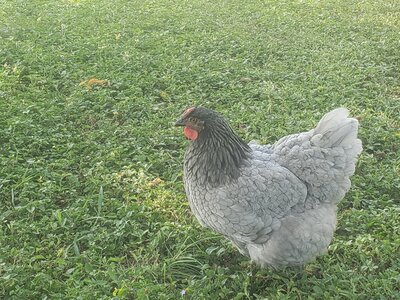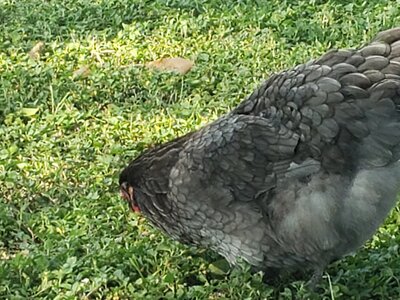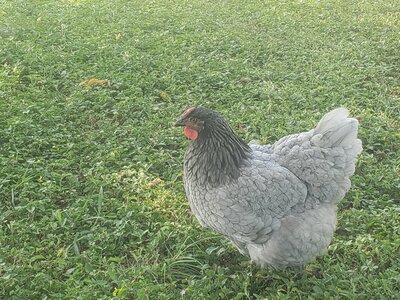Does anyone have any insight on Blue Wyandottes? We purchased 2 WELL were supposed to be blue laced red Wyandottes in March and have turned out to be Blue Wyandottes. We absolutely love these 2 gorgeous girls....however they are the most shy chickens we have. Physical they are a bit bigger than the 7 other girls but are respectfully 8 an 9 in the pecking order. Is this a normal trait? They are the least DRAMA birds we have. We are considering having a full(10 bird)flock if this is their normal way of life. They are in a mixed age and breed flock now and are the babies ...2 buff orpingtons, 2 Barred Rocks, 2 gold laced Wyandottes and 1 silver laced Wyandotte, she lost her breed mate to a predator attack.
Navigation
Install the app
How to install the app on iOS
Follow along with the video below to see how to install our site as a web app on your home screen.
Note: This feature may not be available in some browsers.
More options
You are using an out of date browser. It may not display this or other websites correctly.
You should upgrade or use an alternative browser.
You should upgrade or use an alternative browser.
Blue Wyandottes...
- Thread starter City Farmer Jim
- Start date
Pics
More options
Who Replied?I would love to see pictures of these birds!
- Thread starter
- #3
Pullet Press
Crowing
Aaaaw! She's so cute, and I'm expecting the same for the other.
I have never seen blue Wyandottes before. She is beautiful!Her breed mate is very(camera shy)shy and all but impossible to get a picture of...her plumage is much darker than the one in the picture...they are just the cutest things.
- Thread starter
- #6
Blue and Black Wyandottes are not as popular as other colors because very few people(if any) can breed them to standard which calls for yellow shanks, this is quite difficult task when you breed extended black based birds as this allele has a very strong tendency of laying a dark epidermal layer ontop of the dermis that makes them look black.
Here is a video of how they should look following the SOP by the book
Here is a video of how they should look following the SOP by the book
I had began to notice the shank color in in lavenders, and the blue and black laced red Wyandottes and started wondering what type of challenges I might be facing in my upcoming delights of my breeding both to the SOP and the project colors. Which makes yours an interesting statement of confirmation that many things are not as simple as they may seem on the surface.very few people(if any) can breed them to standard which calls for yellow shanks, this is quite difficult task when you breed extended black based birds as this allele has a very strong tendency of laying a dark epidermal layer ontop of the dermis that makes them look black.

Wyandotte are surprisingly fantastic birds.. after raising dozens of breeds, I have come back to them as solid and well rounded, hardy birds!They are the least DRAMA birds we have.
I find it interesting that your not as impressed with the other varieties of Wyandotte! Those are lovely ladies.. and blue is one of my personal favorite colors to see.. on chickens and cats. Also looks pretty amazing on some dogs and horses, turkeys, rabbits, etc!We are considering having a full(10 bird)flock if this is their normal way of life. They are in a mixed age and breed flock now and are the babies ...2 buff orpingtons, 2 Barred Rocks, 2 gold laced Wyandottes and 1 silver laced Wyandotte, she lost her breed mate to a predator attack.

There is definite difference I have noticed among different varieties of the same breed and I would even say different lines.. in ALL aspects.. hardiness, demeanor, even laying, growth rate, etc.. depending on WHAT has been selected for or not. I was NOT crazy about the blue laced reds visually nor about rose combs. And I don't like popularity wagons which they are on right now.. BUT.. I ordered some in order to work on my "Isabella or Porcelain" laced project.. and I have to admit.. have completely fallen in Love! The splash laced red is also a beautiful color and proving to have great personalities thus far.. noting coming from hatchery.. yep one has a straight comb.
Some of the funnest.. yet wide array of personalities and definitely not all being calm... my most avid foragers ever, hardy.. Easter eggers!
The difference in blue shades is tremendous.. and both fun to see but frustrating as heck with regards to breeding.. when aiming for repeatable and predictable QUALITY.. at least this far in my experience not nearly as simply as black/blue/splash ='s (x) outcome like the simplified charts all show.
Since you have a mix now.. I will say that having birds which are not all the same.. can be easier to tell when someone is having a problem and identify for later inspection. Also easier to tell who lays, makes for a wonderful array of eye candy and helps to balance out things over all with regards to laying during winter or not, broodiness, etc.. So many pluses to keeping a variety. And if these are your first flock.. there are many yet to be discovered! Consider adding a few new chicks of a breed you'd like to try early each spring.. maybe a different breed each year for a few years and see which ones you really like or if you really like the variety.. since according to my current understanding you aren't eating or breeding them.. Is that is your future goals? By adding a few each spring in theory, your eggs will continue each winter.. most first year pullets continue laying despite decreased light. Most 2nd year hens will go into molt and quit laying completely for 2-4 months.. If the future goal doesn't include eating extra.. then Wyandotte are WAY too heavy for me to be comfortable financially to support a flock of 10 JUST for laying.. I would probably go with a more productive layer that was lighter bodied. But I do realize we all have different resources. Also, I guess I just think Wyandotte *might* be a little hot in Texas.. But no matter what I read about Silkies can't free range or go in the rain.. living in the PNW, I have raised any and every breed I wanted to successfully and found most are not nearly as fragile as made out to be.. as long as adequate shelter and nutrition are provided.. So.. You do YOU.

I sell off a couple or so older layers earlier in the year so their new family gets eggs before molt starts, with disclosure that it will happen come fall.. in order to make room in my flock each year for the new layer that will in THEORY come into lay and keep me in eggs year round.
Alternatively planning ahead for the winter lull you can store unwashed eggs in the fridge for 6+ months and have them STILL literally be fresher and more nutritious than store bought eggs!

A few links with some breed comparisons.. most don't note personality or demeanor even slight laying differences between varieties but it's still a pretty good list that loads of fun to review..
pickachicken
Chicken Chart
Breeds of Chickens
New posts New threads Active threads
-
Latest threads
-
losing feathers, has dry skin, dry nub whats happening?
- Started by JackAyla
- Replies: 0
-
-
-
-
-
-
Threads with more replies in the last 15 days
-
-
-
-
How intense is your pecking order?
- Started by thecatumbrella
- Replies: 96
-
I know I’m probably going to upset some ppl, but I’m genuinely confused..
- Started by z3lda3
- Replies: 91
-
×






